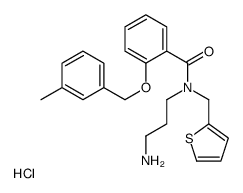AMTB hydrochloride
Modify Date: 2024-01-12 09:38:34

AMTB hydrochloride structure
|
Common Name | AMTB hydrochloride | ||
|---|---|---|---|---|
| CAS Number | 926023-82-7 | Molecular Weight | 430.99100 | |
| Density | N/A | Boiling Point | N/A | |
| Molecular Formula | C23H27ClN2O2S | Melting Point | N/A | |
| MSDS | N/A | Flash Point | N/A | |
Use of AMTB hydrochlorideAMTB hydrochloride is a selective TRPM8 channel blocker. AMTB hydrochloride inhibits icilin-induced TRPM8 channel activation with a pIC50 of 6.23. AMTB hydrochloride can be used for the research of the overactive bladder and painful bladder syndrome. AMTB hydrochloride is a non-selective inhibitor of voltage-gated sodium channels (NaV)[1][2]. |
| Name | N-(3-Aminopropyl)-2-[(3-methylbenzyl)oxy]-N-(2-thienylmethyl)benz amide hydrochloride (1:1) |
|---|
| Description | AMTB hydrochloride is a selective TRPM8 channel blocker. AMTB hydrochloride inhibits icilin-induced TRPM8 channel activation with a pIC50 of 6.23. AMTB hydrochloride can be used for the research of the overactive bladder and painful bladder syndrome. AMTB hydrochloride is a non-selective inhibitor of voltage-gated sodium channels (NaV)[1][2]. |
|---|---|
| Related Catalog | |
| In Vitro | AMTB hydrochloride blocks veratridine-induced membrane potential changes at each NaV1 isoform (pIC50s ranging 4.83-5.69 for NaV1.1- NaV1.8)[2]. AMTB hydrochloride decreases viable cell number in MDA-MB-231 and SK-BR-3 breast cancer cell lines (30 and 100 μM), and also reduces the migration of MDA-MB-231 cells (30 μM)[2]. |
| In Vivo | In the anesthetized rat, AMTB (3 mg/kg; intravenous) hydrochloride decreases the frequency of volume-induced bladder contractions, without reducing the amplitude of contraction[1]. |
| References |
| Molecular Formula | C23H27ClN2O2S |
|---|---|
| Molecular Weight | 430.99100 |
| Exact Mass | 430.14800 |
| PSA | 83.80000 |
| LogP | 6.12900 |